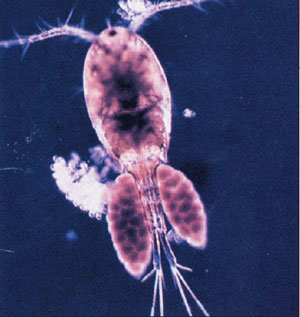Aquatic Mandibulates
 |
| A female copepod bearing eggsacs. |
Subphylum Crustacea (L. crusta, shell) gets its name from the hard shell that most crustaceans bear. Over 30,000 species have been described, and several times that number probably exist. Most familiar to people are the edible ones, for example, lobsters, crayfishes, shrimps, and crabs. In addition to these “crusty” crustaceans, there is an astonishing array of less familiar forms such as copepods, ostracods, water fleas, whale lice, tadpole shrimp, and krill. They fill a wide variety of ecological roles and show enormous variation in morphological characteristics, making a satisfactory description of the group singularly hard to frame.
We live in the age of arthropods, notwithstanding our anthropocentric attachment to our tradition of calling the current era the age of mammals. Together, insects and crustaceans compose more than 80% of all named animal species. Just as insects pervade the terrestrial habitat (more than a million named species and countless billions of individuals), crustaceans abound in oceans, lakes, and rivers. Some walk or creep on the bottom, some burrow, and some (such as barnacles) are sessile. Some swim upright, others swim upside down, and many are delicate microscopic forms that drift as plankton in the oceans or in lakes. Indeed, it is probable that the most abundant animals in the world are members of the copepod genus Calanus. In recognition of their dominance of marine habitats, it is understandable that crustaceans have been called “insects” of the sea.
Arthropods that possess mandibles (jawlike appendages) are known as mandibulates and traditionally have been united in subphylum Mandibulata. As we noted in the previous section, some authors think that phylum Arthropoda is polyphyletic and that arthropodization occurred more than once. In addition, many investigators now believe that there are sufficient differences between crustaceans and uniramians (insects, millipedes, centipedes, pauropods, and symphylans) to justify separation at least to subphylum level. Both Crustacea and Uniramia have, at least, a pair of antennae, a pair of mandibles, and a pair of maxillae on the head. These appendages perform sensory, masticatory, and food-handling functions, respectively. The body may consist of a head and trunk, but in the more derived forms, a high degree of tagmatization has occurred so that there is a well-defined head, thorax, and abdomen. In most Crustacea one or more thoracic segments are fused with the head to form a cephalothorax. Thoracic and abdominal appendages are mainly for walking or swimming, but in some groups they are highly specialized in function. Crustacea are mainly marine; however, there are many freshwater and a few terrestrial species, whereas uniramians are mainly terrestrial. There are numerous species of insects in freshwater habitats, but only a few in marine.




